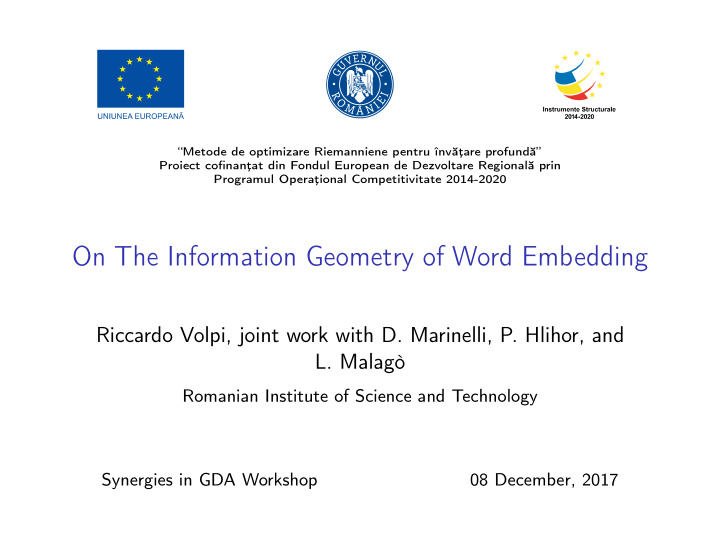



“Metode de optimizare Riemanniene pentru învăţare profundă” Proiect cofinanţat din Fondul European de Dezvoltare Regională prin Programul Operaţional Competitivitate 2014-2020 On The Information Geometry of Word Embedding Riccardo Volpi, joint work with D. Marinelli, P. Hlihor, and L. Malagò Romanian Institute of Science and Technology Synergies in GDA Workshop 08 December, 2017
Word Embedding A word embedding maps the words of a dictionary in a real vector space, based on the notion of context “You shall know a word by the company it keeps” . Firth, 1957. 1/6
Word Embedding A word embedding maps the words of a dictionary in a real vector space, based on the notion of context “You shall know a word by the company it keeps” . Firth, 1957. p ( χ ∣ w ) = exp ( u T w v χ )/ Z w Analogies of the form a ∶ b = c ∶ d can be solved by ∥ u a − u b − u c + u d ∥ 2 = arg min d ( ln p ( χ ∣ a ) p ( χ ∣ b ) − ln p ( χ ∣ c ) 2 = arg min p ( χ ∣ d )) ∑ c χ ∈ D ▸ The space of word embedding has a linear geometry (cf. Arora et. al., ▸ The general model used by ’16), where vectors express semantic Skip-Gram (Mikolov et. al., ’13) and relationships between contexts Glove (Pennington et. al., ’14) 1/6
Exponential Family and Conditional Distributions Consider the joint probability distribution for W and X p ( χ,w ) = exp ( w T Cχ )/ Z, with C = U T V ▸ Conditional distributions p ( χ ∣ w ) = exp ( u T w v χ )/ Z w lay on the boundary of the joint statistical model ▸ Each column vector of U identifies a p w in the conditional model ▸ For a fixed V , all conditional simplexes are homomorphic one to each other 2/6
Exponential Family and Conditional Distributions Consider the joint probability distribution for W and X p ( χ,w ) = exp ( w T Cχ )/ Z, with C = U T V ▸ Conditional distributions p ( χ ∣ w ) = exp ( u T w v χ )/ Z w lay on the boundary of the joint statistical model ▸ Each column vector of U identifies a p w in the conditional model ▸ For a fixed V , all conditional simplexes are homomorphic one to each other We aim at characterizing the geometry of word embedding, based on alternative geometries for the exponential family studied in Information Geometry (Amari and Nagaoka, ’00) 2/6
Geometric Word Analogies Let p w be the conditional probability p ( χ ∣ W = w ) , and p a reference context ▸ The logarithmic map M → T p M is defined by a = Log p a ( p b ) ∆ p b ▸ The parallel transport of A p A ∶ T p a M → T p M Π p a ▸ Norms are computed by p = a T I ( p ) a , where I ( p ) is ∥ A ∥ 2 the Fisher information matrix Analogies of the form a ∶ b = c ∶ ? can solved by 2 ∥ Π p a p ∆ p b a − Π p c p ∆ p d c ∥ arg min p , d 3/6
The Framework in Practice: The Full Simplex ▸ For d = # ( D ) , any point ( ρ ) χ in the interior of the simplex corresponds to a conditional probability p ( χ ∣ W = w ) ▸ By setting ρ ↦ √ ρ , the probability simplex is mapped to the positive spherical orthant and the geometry of the sphere is obtained 4/6
The Framework in Practice: The Exponential Family ▸ For d ≤ # ( D ) , the Riemannian geometry of the exponential family is defined by the Fisher-Rao metric ▸ Moreover, there are at least two other affine geometries of interest: the exponential geometry and the mixture geometry 5/6
The Framework in Practice: The Exponential Family ▸ For d ≤ # ( D ) , the Riemannian geometry of the exponential family is defined by the Fisher-Rao metric ▸ Moreover, there are at least two other affine geometries of interest: the exponential geometry and the mixture geometry ▸ [Proposition] Let p 0 be the uniform distribution over D , e Π q p , and e ∆ p b a be defined according to the exponential geometry, under the hypothesis of isotropy distribution for the v ’s 2 ∥ e Π p a p ( e ∆ p b a ) − e Π p c p ( e ∆ p d c )∥ arg min p 0 , d reduces to ∥ u a − u b − u c + u d ∥ 2 , arg min d 5/6
Conclusions and Future Perspectives ▸ The language of Information Geometry can be used to describe the geometry of word embeddings ▸ We have defined a parameter-invariant way to solve word analogies ▸ The exponential geometry of the exponential family allows to recover the standard way to solve word analogies ▸ Evaluating experimentally the role of different geometries of word embedding 6/6
Conclusions and Future Perspectives ▸ The language of Information Geometry can be used to describe the geometry of word embeddings ▸ We have defined a parameter-invariant way to solve word analogies ▸ The exponential geometry of the exponential family allows to recover the standard way to solve word analogies ▸ Evaluating experimentally the role of different geometries of word embedding “One geometry cannot be more true than another; it can only be more convenient” . Henri Poincaré, Science and Hypothesis, 1902. 6/6
Recommend
More recommend